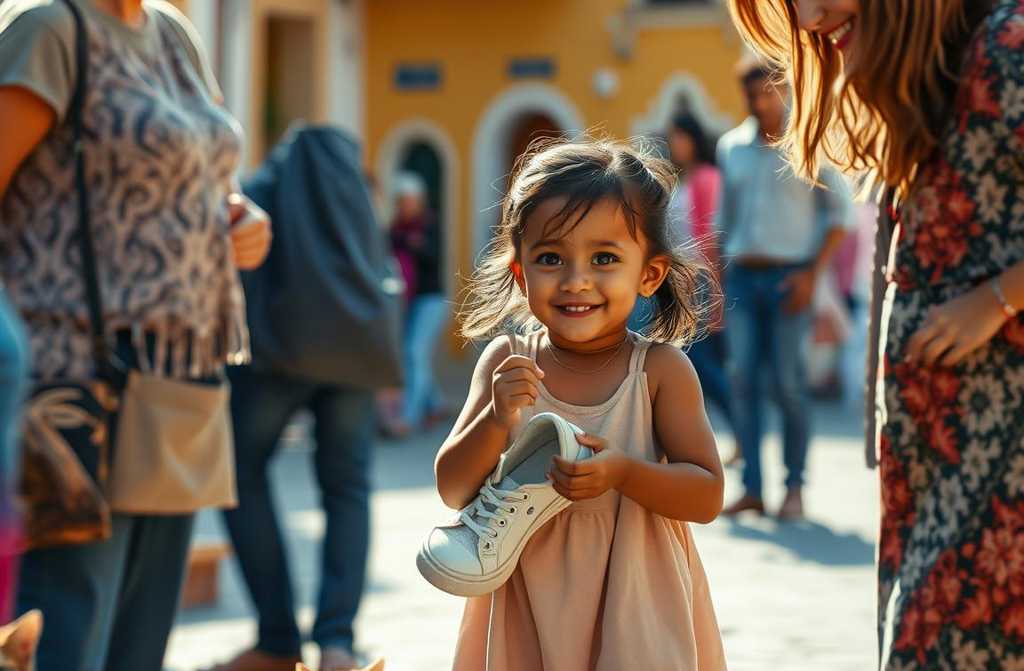З життя
Stella’s Shoes: A Tale of Glamour and Destiny

In the cobbled lanes of Stratford-upon-Avon, where the quaint timber-framed houses nestled beneath the rolling green hills, young Emily walked barefoot, her soles toughened by years of wandering without shoes. At eleven, she knew every uneven stone, every puddle, and every crack in the narrow streets. Her feet, though small and slender, were sturdy and quiet, carrying her through the bustle of market days and the hush of Sunday mornings.
Her mother wove bracelets from dyed wool, selling them to visitors who lingered by the old stone cross in the square, while her father called out prices for roasted chestnuts, his voice ringing above the chatter. They were not poor in spiritlaughter filled their cottage with its thatched roof and creaking oak door. But coin was scarce, and often Emily stayed home to mind her baby brother, Thomas, whose first words were still sweet and stumbling.
One evening, as Emily swept the square after the crowds had gone, a lady from London noticed her bare feet. The womans gaze lingered on Emilys dust-streaked toes, and she knelt with a gentle frown.
“Why havent you any shoes, child?”
Emily shrugged, her eyes steady but bright with quiet pride. “Mine wore out months ago,” she said. “Theres none to spare.”
Touched by her honesty, the woman drew a pair of nearly new trainers from her bagwhite with a streak of blueand pressed them into Emilys hands. That night, Emily clutched them like treasure, polishing them before bed as Thomas watched wide-eyed and the neighbours tabby cats sniffed curiously at the unfamiliar scent.
The next morning, she wore them to school, her chin lifted not in vanity but in quiet dignity. For the first time, she didnt tuck her feet beneath the bench or hide them under her frayed hem. Each step echoed on the cobbles, as if the stones themselves nodded in respect.
But soon, whispers curled around her.
“Look at Miss Fancy,” a boy jeered. “Thinks shes grand with her new shoes.”
The laughter stung worse than icy puddles. That afternoon, she tucked the trainers into a sack, her mothers brow furrowing.
“Whats wrong, love?”
“Best keep em clean,” Emily murmured.
She couldnt explain how poverty made kindness feel like a sin, or how pride was mistaken for arrogance. Humility, shed learned, wasnt in what one wore but in how one walked.
Weeks later, a charity arrived, seeking children for a photography exhibita glimpse of ordinary courage in the English countryside. Emily was chosen. They captured her in the trainers, standing before their cottage, a wildflower clutched in her palm. The image travelledto London, to Edinburgh, even across the sea. A journalist came seeking her.
“Your pictures in a gallery,” he said. “People want to know the girl with the bright eyes and white shoes.”
Emily blinked at her mother, who wept silent, shining tears.
“Why would they care about me? No one notices me here.”
“Because you remind them,” he said softly, “that even simple things, seen with love, become art.”
She slipped the trainers on again and walked the square, head high. The taunts no longer mattered. Beauty wasnt just in being seenit was in refusing to hide.
In time, her story spread. Other children began to stand taller, to cherish their own small treasures. Mothers whispered of letting young hearts bloom unashamed.
Emilys trainers grew scuffed with mud and memory, yet she walked on, her quiet gaze saying, *Look at me. Look at my world.*
For sometimes, shoes arent just for feet. They shield doubt, soften shame, and let a childs light spill into the world.
Years later, she returned to the square and saw barefoot girls watching her. She smilednot to preach, but to show them how to walk with hope.
Because miracles arent always vast. Sometimes, theyre a flower, a kind glance, or the courage to stride forward, unafraid.

















